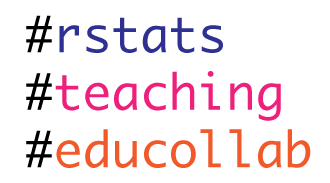All posts (Page 80 of 126)

🔗
Motivation
Note: Recently, two new UMAP R packages have appeared. These new packages provide more features than umapr does and they are more actively developed. These packages are:
...umap, which provides the same Python wrapping function as umapr and also an R implementation, removing the need for the Python version to be installed. It is available on CRAN.uwot, which also provides an R implementation, removing the need for the Python version to be installed.
tl;dr: we propose three calls to action:
- Share your curricular materials in the open.
- Participate in the rOpenSci Education profile series.
- Discuss with us how you want to be involved in rOpenSci Educators’ Collaborative.
In previous posts in this series, we identified challenges that individual instructors typically face when teaching science with R, and shared characteristics of effective educational resources to help address these challenges. However, the toughest challenges that educators in this area face are human, rather than technological. Our shared experiences highlight the need for a strong community of innovative R educators. However, this community is currently not well-connected or easily discoverable.
...In the first post of this series, we sketched out some of the common challenges faced by educators who teach with R across scientific domains. In this post, we delve into what makes a “good” educational resource for teaching science with R.

For instructors teaching sciences with R, there are a number of open educational resources that they can reuse, tailor to their own teaching style, or use to inspire them in creating their own materials. Some examples:
...
Educators who teach science using R tend to face common pedagogical problems, regardless of their scientific domain. Yet instructors who teach with R often feel isolated at their institutions. They may be the only ones in their departments to teach using R. Even if there are others, the culture of collaboration around teaching is generally impoverished, unlike the rich culture of collaboration around research. In this three-part series of blog posts, participants at the rOpenSci 2018 unconf briefly survey the state of teaching science with R.
...The gifski package which was demonstrated in May at eRum 2018 in Budapest is now on CRAN. Gifski is a simple but powerful package which can hopefully take away an important performance bottleneck for generating animated graphics in R.
🔗
What is Gifski
Gifski is a multi-threaded high-quality GIF encoder written in Rust. It can create animated GIF images with thousands of colors per frame and do so much faster than other software. The Gifski Website has more technical details and beautiful examples.
...



